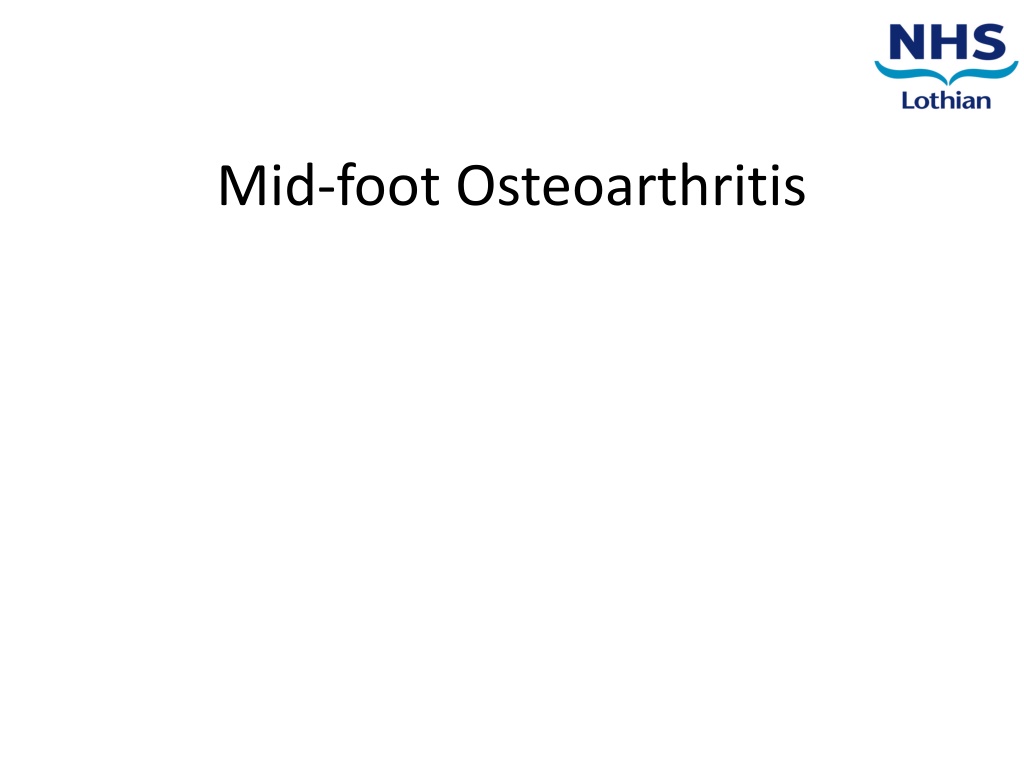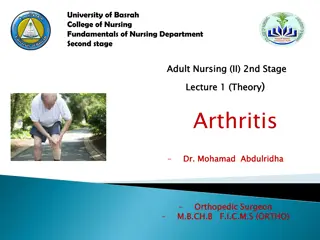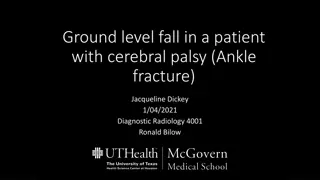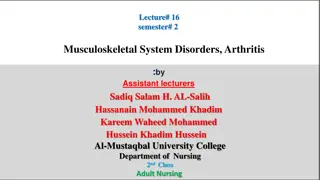Understanding Midfoot Osteoarthritis: Causes, Symptoms, and Management
Midfoot osteoarthritis is characterized by arthritic changes in the joints of the midfoot, leading to pain, restricted movement, and swelling. Common causes include previous trauma, foot surgery, and weight issues. Diagnosis involves physical examination and sometimes x-rays. Management includes self-care with pain relief, activity modification, and lifestyle changes. Self-directed foot exercises and consultation with healthcare professionals for medication may also help manage the condition effectively.
Uploaded on Sep 24, 2024 | 0 Views
Download Presentation

Please find below an Image/Link to download the presentation.
The content on the website is provided AS IS for your information and personal use only. It may not be sold, licensed, or shared on other websites without obtaining consent from the author. Download presentation by click this link. If you encounter any issues during the download, it is possible that the publisher has removed the file from their server.
E N D
Presentation Transcript
Contents 1. What is Midfoot Osteoarthritis? 2. What are the causes? 3. What are the symptoms? 4. How is it diagnosed? 5. What is the management? 6. How can I manage it?
What is Midfoot Osteoarthritis? Arthritic or degenerative changes within joints of the mid- foot.
What are the causes What are the causes/risk factors? Many cases occur spontaneously without a specific cause. Previous trauma. Previous foot surgery. Body weight. Foot mechanics It is estimated that 12% of population over 50 have painful arthritis in their mid-foot.
What are the symptoms? Pain on top of your foot over the middle which may extend into the arch. Restricted movement in foot. Bony prominence/swelling on the top of your foot.
How is it diagnosed? An appropriate healthcare professional will discuss your foot symptoms and enquire about your general health. A physical examination of your foot will be carried out to assess your movement, response to particular tests and level of pain. An x-ray is sometimes required to confirm clinical diagnosis.
What is the management? Many patients are happy to self-manage their symptoms, with painkillers/anti-inflammatory medication or other non-invasive treatments such as: Lifestyle and health changes Activity Modification Wearing appropriate footwear. Podiatry/Physiotherapy
Lifestyle & Health Changes Maintaining a healthy diet and weight Getting 7-9 hours of quality sleep per night Reducing alcohol intake Quit smoking Not all of these recommendations will be relevant to everyone, but these are important factors to consider to optimise your outcome. Click this link for more information and support options
How can I manage it? Rest/immobilisation/activity modification, as required. Self directed foot exercises. Simple pain relief or anti- inflammatory medication - Consult your GP or Pharmacist Appropriate footwear - Stiff soled footwear or shoes with a rocker bottom. Image result for pain relief
Physiotherapy Podiatry/Physiotherapy Through a thorough examination, a Podiatrist or Physiotherapist can : Help you establish what may be causing your pain Provide you with an individualised treatment plan to help and/or resolve symptoms. Advise and arrange further investigation, if required Treatments provided include; -Exercises. -Advice on footwear and activity modification. -Foot orthoses/insoles.
More Invasive Management Options In some cases symptoms may persist and more invasive treatments may be required/requested by you, as the patient: Corticosteroid injection Surgery
Injection Steroid injections: - This can be carried depending on the severity of the Osteoarthritis. - Sometimes this has be performed with ultrasound guidance.
Surgery Surgery is only required if pain is present and symptoms are unable to be controlled by more conservative methods, as described above.























